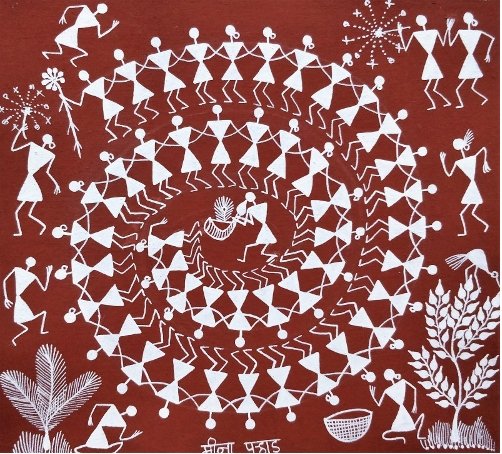Introduction
Indian folk art is a vivid patchwork that combines a wide range of hues, legends, and customs to represent the rich cultural diversity of this ancient country. The variety of Indian folk art is reflected in the detailed paintings and emotive drawings produced by the various communities that produce it. We’ll explore the fascinating world of Indian folk art in this piece, with special attention to the well-known Madhubani style and other age-old forms that have endured.
The Allure of Madhubani Indian Folk Art
Madhubani, originating from the Mithila region of Bihar, is a distinctive form of Indian folk art that has gained international acclaim. Known for its vivid colours, bold lines, and symbolic motifs, Madhubani paintings often depict scenes from mythology, nature, and daily life. Artists use a unique combination of geometric patterns and freehand designs, creating visually stunning compositions that tell stories passed down through generations.

Traditional Indian Folk Art Forms
Beyond Madhubani, India boasts a diverse array of traditional folk art forms, each with its own distinct characteristics. Warli paintings from Maharashtra capture the simplicity of tribal life with stick figures and basic shapes. Patachitra from Odisha showcases intricate storytelling on scrolls or cloth, often depicting scenes from epics like the Ramayana and Mahabharata. Tanjore paintings from Tamil Nadu are known for their rich colours, gold leaf embellishments, and depictions of deities.

Types of Indian Folk Art
Indian folk art is a treasure trove of creativity, encompassing a wide range of styles. From the tribal art of Gond and the vibrant Kalamkari from Andhra Pradesh to the intricate Phad paintings of Rajasthan, each style has its unique identity. Exploring these diverse forms provides a glimpse into the cultural nuances and regional flavours that define Indian folk art.

Folk Arts of Indian States
India’s diverse states contribute to the kaleidoscope of folk art, with each region having its own signature style. For example, the Kangra school of miniature paintings in Himachal Pradesh captures the scenic beauty of the Himalayan region, while the Mata Ni Pachedi of Gujarat narrates tales of the goddess through fabric art. Understanding the folk arts of different states offers a fascinating journey through the cultural heritage of the subcontinent.

Indian Folk Art for Beginners
For those eager to try their hand at Indian folk art, there are plenty of accessible options. Simple and easy-to-follow tutorials make it possible for beginners to create their own masterpieces inspired by traditional styles. Whether it’s a Madhubani-inspired painting or a Warli-style drawing, exploring these art forms can be a rewarding and enjoyable experience.
Conclusion
Indian folk art is a celebration of diversity, culture, and the timeless stories that bind communities together. From the intricate beauty of Madhubani to the simplicity of Warli, each art form tells a unique tale of India’s rich heritage. Whether you’re an artist, an enthusiast, or someone looking for a creative outlet, the world of Indian folk art invites you to embark on a colourful journey through the heart of this vibrant and culturally rich nation.
Feature Image Courtesy: Avidipta.art
Discover the Allure of Lippan Art: A Guide to Techniques, Materials, and Creative Expression





